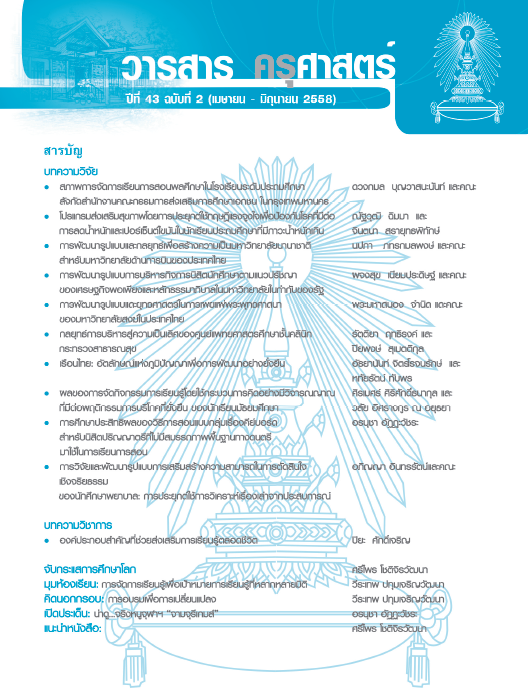การพัฒนารูปแบบและกลยุทธ์เพื่อสร้างความเป็นมหาวิทยาลัยนานาชาติ สำหรับมหาวิทยาลัยด้านการบินของประเทศไทย
Keywords:
MODEL, STRATEGY, INTERNATIONAL, รูปแบบ, กลยุทธ์, นานาชาติAbstract
การวิจัยนี้มีวัตถุประสงค์เพื่อศึกษาและวิเคราะห์การบริหารการจัดหลักสูตร รวมถึงปัญหาและอุปสรรคของสถาบันอุดมศึกษาในการเปิดสอนหลักสูตรด้านการบินทั้งในประเทศไทยและต่างประเทศ พัฒนารูปแบบของมหาวิทยาลัยนานาชาติด้านการบินของประเทศไทย และพัฒนากลยุทธ์ของมหาวิทยาลัยนานาชาติด้านการบินของประเทศไทย โดยการใช้เทคนิควิธีวิจัยแบบ EDFR ในการพัฒนารูปแบบมหาวิทยาลัยนานาชาติด้านการบิน และใช้เทคนิควิธีวิเคราะห์สิ่งแวดล้อมและตารางวิเคราะห์การจับคู่จุดแข็ง จุดอ่อน โอกาส และอุปสรรค (TOWS Matrix) ในการพัฒนากลยุทธ์มหาวิทยาลัยนานาชาติด้านการบิน
ผลการวิจัยพบว่า 1) ในภาพรวม การบริหารจัดการของหลักสูตรด้านการบินของสถาบันอุดมศึกษาในประเทศไทยสามารถดำเนินการอยู่ได้ แม้ว่าบางสถาบันจะเผชิญกับข้อจำกัดดังต่อไปนี้ คือ การขาดแคลนบุคลากรที่มีความเชี่ยวชาญเฉพาะทางด้านการบิน ค่าตอบแทน อาคารสถานที่ อุปกรณ์และเครื่องมือในการจัดการเรียนการสอน ในขณะที่สถาบันอุดมศึกษาในต่างประเทศไม่ค่อยพบปัญหาเหล่านี้ 2) รูปแบบของมหาวิทยาลัยนานาชาติด้านการบินของประเทศไทยที่พัฒนาขึ้นนี้ เป็นรูปแบบของมหาวิทยาลัยในระดับปริญญาบัณฑิต เป็นมหาวิทยาลัยใหม่ในกำกับของรัฐ มีวิทยาเขตเดียว มีหลักสูตรเป็นหลักสูตรทางด้านการบินที่มีมาตรฐานระดับสากล มหาวิทยาลัยมีความเป็นเลิศทางด้านการเรียนการสอนเฉพาะทาง และการวิจัยและพัฒนาทางด้านการบิน พัฒนาบุคลากรและพัฒนาองค์ความรู้ทางด้านการบิน เพื่อพัฒนาอุตสาหกรรมการบินของไทย ภูมิภาคอาเซียน และภูมิภาคอื่นๆ ทั่วโลก และ3) กลยุทธ์ในการดำเนินงานที่พัฒนาขึ้นจากงานวิจัยนี้ มี 7 กลยุทธ์ คือ (1) กลยุทธ์สร้างภาพลักษณ์มหาวิทยาลัยนานาชาติด้านการบิน (2) กลยุทธ์พัฒนาขีดความสามารถของมหาวิทยาลัยไปสู่มาตรฐานระดับนานาชาติที่สูงขึ้น (3) กลยุทธ์บริหารงานทั่วไปด้วยคุณภาพระดับสากล (4) กลยุทธ์บริหารวิชาการด้วยคุณภาพระดับสากล (5) กลยุทธ์บริหารงานวิจัยเพื่อพัฒนาอุตสาหกรรมการบินระดับชาติและนานาชาติ (6) กลยุทธ์บริหารการเงินด้วยคุณภาพระดับสากล และ (7) กลยุทธ์บริหารทรัพยากรมนุษย์ด้วยคุณภาพระดับสากล
The purposes of this study were to study and analyze aviation program management in Thailand and overseas including problems and obstacles, to develop an international aviation university model in Thailand, and to develop the operational strategies for an international aviation university. The EDFR technique was used to develop a model for the international aviation university while a SWOT analysis and the TOWS Matrix techniques were used to develop the operational strategies for the university.
The results were as follows: 1) Overall, the aviation program management of higher education institutions in Thailand can operate, despite the following problems and obstacles in some institutions: a shortage of instructors specialized in aviation subjects, low compensation, and inadequate instructional equipment and facilities. However, these issues were rarely found in the researched institutions abroad. 2) The model of an international aviation university in Thailand was developed specifically to be a university which is brand new, autonomous, serving the undergraduate-level, with a single-campus and focusing on aviation specialized to international standards and striving to be excellent in aviation education, training and research in order to develop aviation personnel and enhance aviation knowledge to further develop the aviation industries in Thailand, the ASEAN region and others around the world. 3) There were 7 operational strategies developed: (1) a strategy for international aviation university brand image building, (2) a strategy for improving university capability toward higher-level international standards, (3) a strategy for general management with application of global standards, (4) a strategy for academic administration applying world-class standards, (5) a strategy for research management for developing both the national and international aviation industries, (6) a strategy for financial management applying world-class standards, and (7) a strategy for effective human resource management up to global standards.



